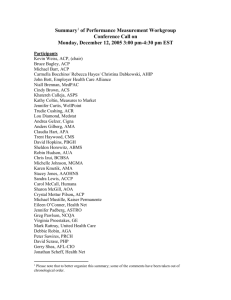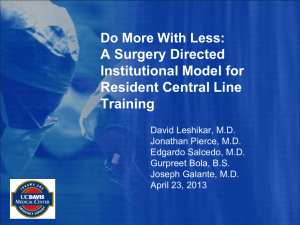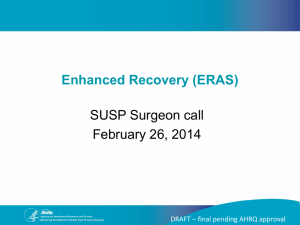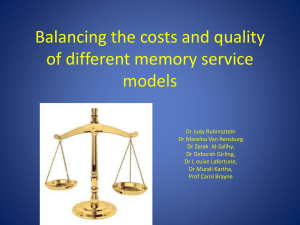A Systems and Human Factors Approach to Patient Safety
advertisement
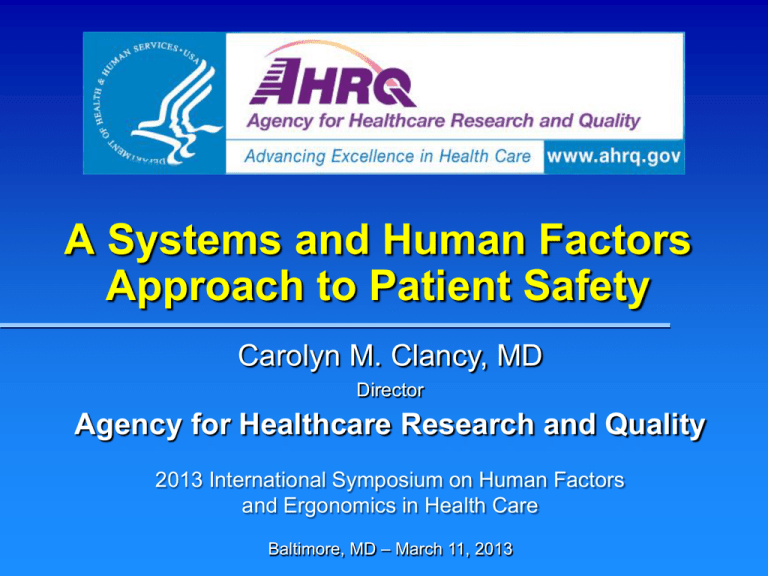
A Systems and Human Factors Approach to Patient Safety Carolyn M. Clancy, MD Director Agency for Healthcare Research and Quality 2013 International Symposium on Human Factors and Ergonomics in Health Care Baltimore, MD – March 11, 2013 Our Health Care System “Health care is composed of a large set of interacting systems – paramedic, and emergency, ambulatory, impatient care, and home health care; testing imaging laboratories; pharmacies; and so forth – that are coupled in loosely connected but intricate networks of individuals, teams, procedures, regulations, communications, equipment and devices that function with diffused management in a variable and uncertain environment.” To Err is Human: Building a Safer Health System Swiss Cheese Model of Accident Causation “Rather than being the main instigators of an accident, operators tend to be inheritors of system defects created by poor design, incorrect installation, faulty maintenance and bad management decisions. Their part is usually that of adding the final garnish to a lethal brew whose ingredients have already been long in the cooking.” Reason, 1990 A Systems and Human Factors Approach to Patient Safety AHRQ Focus and Priorities 21st Century Health Care Needs a Human Factors Voice Where to From Here? Q&A AHRQ Priorities Patient Safety Health IT Patient Safety Ambulatory Patient Safety Safety & Quality Measures, Organizations Patient Safety Grants (incl. simulation) Drug Management, & Patient-Centered Care Survey of Patient Safety Culture Diagnostic Error Research Medical Expenditure Panel Surveys Visit-Level Information on Medical Expenditures Annual Quality & Disparities Reports Effective Health Care Program Comparative Effectiveness Reviews Patient-Centered Outcomes Research Clear Findings for Multiple Audiences Other Research & Dissemination Activities Quality & Cost-Effectiveness, e.g., Prevention & Pharmaceutical Outcomes U.S. Preventive Services Task Force MRSA/HAIs AHRQ’s TOP 3 Focus Areas Patient Safety • Build a “trustworthy” delivery system, minimize the impact of adverse events Quality • Focus on the National Quality Strategy and collaboration (HHS, private sector) “Getting to HOW” • Practical, evidence-based process improvements Translation of Human Factors to Health Care is Straightforward Human Factors as a Discipline . . . takes into account human strengths and limitations in the design of interactive systems of people, tools and technology, and environments to ensure safety, effectiveness and ease of use Human Factors in Health Care . . . takes into account patient and provider capabilities in the design of interactive health care systems of people, devices and technology, and environments to ensure safety, effectiveness and ease of delivering care Teamwork Expanding Our Overall Capability Facilitates shared mental models Encourages cross-training and spread of skills Increases quality of group decision-making Improves cooperation among specialty areas Improves job satisfaction Labor & Delivery Team at North Bronx Healthcare Network The New York Public Hospital System uses TeamSTEPPS Designing Quality and Safety Into the Hospital Environment Evidence-Based Design – Build Private Rooms – Reduce Noise – Incorporate Nature – Improve Air Quality – Encourage Hand Hygiene – Improve Wayfinding – Reduce Walking Distance Designing Quality and Safety Into the Home Care Environment Health Care Comes Home: The Human Factors Systematic investigation of the role of human factors in home health care – – – Very few homes have been designed for the delivery of health care Medical equipment and technology designed for hospitals and clinics can be ill-suited for home use Includes findings and recommendations for maximizing opportunities to improve home health care AHRQ-supported study by the Board on Human-Systems Integration of the National Research Council CUSP Cuts CLABSIs by 40% in 1,100 Hospital Units Could there be an equivalent headline for diagnostic error? CUSP for CLABSI Infection prevention evidence-based practices Frontline use of checklists Unit-wide patient safety culture Local leader champion Engaging/educating team Collecting performance & outcome measures CUSP for DX Error What should be targeted? Is there an evidencebase? What tools are available? Who owns the problem? What teams need to be engaged? How is diagnostic performance measured? Diagnostic Errors: The Next Frontier in Patient Safety? “Unfortunately, reliable decision support or feedback systems do not yet exist.”* “Triggers” of electronic health records can help identify potential diagnostic errors in primary care settings – – – Refining triggers and reducing false positives led to detection methods that are far more efficient than conducting random record review or relying in incident reporting systems Usefulness ultimately will depend on continued efforts to improve their reliability Primary care reform initiatives should consider these methods for error surveillance Electronic Health Record-Based Surveillance of Diagnostic Errors in Primary Care BMJ Qual Saf 2012;21:93-100. * Patient Safety Primer: Diagnostic Errors http://psnet.ahrq.gov Recent Literature Reviews Find Few Outcome Studies System-related interventions (Singh et al., 2012) Our literature review of system-related interventions to reduce diagnostic error . . . yielded very few empirical outcome studies. . . Our findings highlight a large gap between suggested interventions and those that have been operationalised and evaluated empirically Cognitive interventions (Graber et al., 2012) We found that most interventions. . . were simply ideas or suggestions. Many of these are well conceptualised and widely endorsed, and seem ripe to be tested in experimental and real-world clinical settings. . . Our findings also affirm that the science of outcome measurement in this area is underdeveloped The Double-Sided Nature of Health IT Purported Benefits Concerns Information is the lifeblood of health care With IT, providers can make better decisions, avoid duplication of tests and procedures, and prevent unwanted medication interactions PCMHs and patient engagement more easily realized In-home monitoring allows tracking of patient vitals and activity Lack of system standardization and interoperability can limit data sharing No central repository to collect/analyze IT-related safety glitches Most systems are vendor inspired; user needs, workflow, and usability issues have been neglected Data entry/retrieval and awkward interfaces are issues Improving Electronic Medical Records (EMRs) As currently designed, EMRs and Health IT often add another layer of complexity The shortcomings need continued attention; vendors and HCOs need to work together on design, implementation and use issues Users should be involved at the earliest stages of design It’s not just the technology. IT needs to be aligned with the needs of the greater sociotechnical system – the organizations, people, and clinical processes that interact and depend on it Improvement is a steady, incremental process Human Factors Design Guide Designed to help designers and developers of consumer health IT: – – – User-friendly applications for a wide range of life situations Assist home health professionals in selecting tools to complement professional health care services Create new kinds of consumer health IT and strategies to increase use AHRQ-funded study available at: www.nap.edu/catalog.php?record_id=13205 Simulation: A Rapidly Growing Training & Test Bed Technology Learn skills in simulated setting first Risk free environment for learning Integration of multiple skills Immediate and realistic feedback; actions have consequences Readily available Simulation Training for CVC Insertion Purpose: RCT of Yale medical students on whether simulation training of ultrasound (US)guided central venous catheter (CVC) insertion on simulated trainer improves cannulation and insertion success rates Results: 495 CVC insertions by 115 residents over 21-month period. Successful first cannulation in 51% of intervention group versus 37% of control group. CVC insertion success for 78% of intervention versus 67% of control group Conclusion: Simulation training improved performance of CVC insertion compared to control group Evans LV et al. “Simulation Training in Central Venous Catheter Insertion: Improved Performance in Clinical Practice.” Acad Med. 2010: 85:1462-1469. Where to From Here? Do more to ensure that new treatments and research knowledge reach patients and are implemented correctly Improve quality by improving access Expand the boundaries of basic science to include other “basic sciences” (e.g., epidemiology, psychology, communication, social marketing and economics) More focus on research and delivery of existing treatments AND interaction between social determinants and health care Woolf, S. The Meaning of Translational Research and Why It Matters, JAMA January 2009 Future Needs: How You Can Help Early indicators of likely success Share success and productive failures with www.innovations.ahrq.gov Learn from variation in the different systems Help us learn about “spillover” effects – i.e., does one successful innovation make the next one easier and faster?? Thank You AHRQ Mission To improve the quality, safety, efficiency, and effectiveness of health care for all Americans AHRQ Vision As a result of AHRQ's efforts, American health care will provide services of the highest quality, with the best possible outcomes, at the lowest cost www.ahrq.gov

